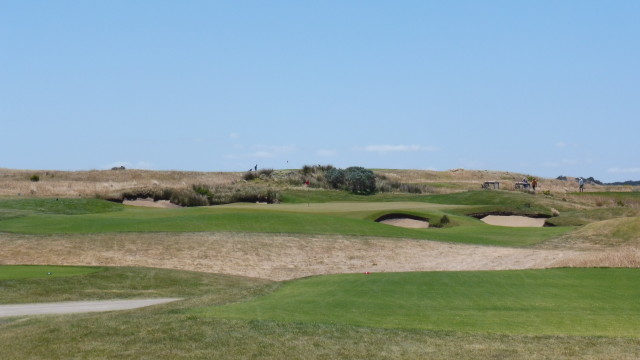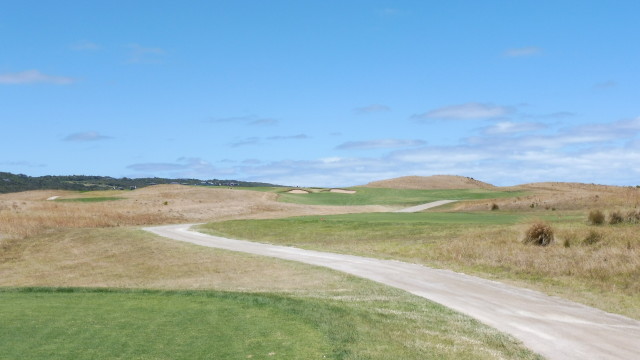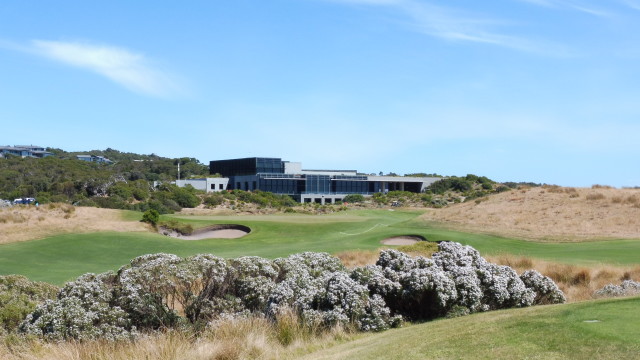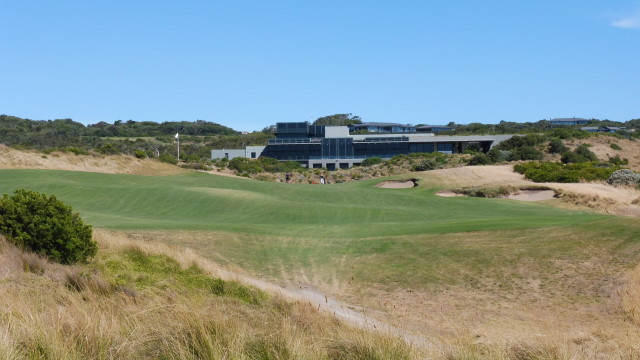
Location: Cape Schank, VIC
Established: 2000
Architect: Thomson, Wolveridge & Perrett
First Played: 28th Dec 2015
Last Played: 21st Mar 2017
Magazine Ratings

50 (2018)

55 (2018)
Note – This visit is for the Ocean course. It went under full renovation and renamed to Gunnamatta in 2019
With my goal set to reach 75 courses played for the year, I was still one short. This had to be a memorable course, my first preference was Barwon Heads but it was fully booked. Contacting an old acquaintance, Harry, opened up the opportunity to play at The National, so my goal for the year was going to be reached.

Entrance to The National Golf Club
Driving in the gate you see the rolling hills and farmland, questioning whether there is a golf course anywhere on the grounds. The further you go in you start seeing glimpses of the course and some of the luxury residential properties on the course, although these are minimal and do not impede on the course at all. Finally you arrive to the grand clubhouse, which has quite a bit of memorabilia from some of the tournaments held and the outstanding practice facilities available, which even rival those at Augusta National (well maybe exaggerated but they are still good).

Clubhouse at The National Golf Club
The National Golf Club was first launched during the Australian Masters tournament at Huntingdale Golf Club in 1985 as an equity shareholding. It was the first new club in Melbourne in 60 years. By 1988 the Robert Trent Jones Jnr designed links style course had been completed, known now as the Old Course.

Map of The National Golf Club Ocean Course
In 1996 the Club had acquired adjoining property, land which was spectacular to create a natural links course amongst the sand dunes along the coastline. This lead to two further courses being created, the Moonah Course designed by Greg Norman and Bob Harrison and the Ocean course, designed by Thomson, Wolveridge and Perrot, both of which were opened in 2000. The creation of the later two courses lead to a new clubhouse being built and re-routing of The Old course.

The National Golf Club Ocean Course Scorecard
The Ocean course is not regarded as one of the The Nationals strongest, so I was never in a real hurry to play. But having read that the Ocean course will undergo some renovations by Tom Doak, it seemed a great idea to play before any changes had been made. Too many times I have played a course after significant changes, so I wasn’t passing up this opportunity.

Hole 1 – 464 meter par 5
A nice opening hole, playing from an elevated tee to a split fairway. This certainly stood out, reminding me a little of the 8th at Barnbougle Dunes, as there are not too many holes in the country that have this unique feature. This gives quite a wide fairway to hit for the first shot of the round, but finding the bunkers will make play a lot more difficult.

Play from the lower section of the 1st fairway
The right side of the fairway opens up the green, from an elevated position, but also had more undulation to deal with, potentially leaving an awkward stance. Playing down the left brings bunkers into play closer to the green, but also could see the ball run off the fairway due to the larger sloping ground. Like the first major decision from the tee.

Looking back from 1st green
The green itself stands out, raised well above the fairway, but more so for the large false front. Being short could see the ball roll well back down the fairway. Long on the hole isn’t ideal either, with a green running away that is not so deep, speed becomes essential to staying on the green. Overall a good opening hole with a bit of strategy, but not extremely punishing if you get it wrong.

Hole 2 – 345 meter par 4
Asking a bit more on the tee shot is the second. Play is over a hill in the distance with bunkers lining the left, with the fairway narrowing dramatically at this point. It is possible to carry the bunkers/hill, especially down wind, but with a head wind, this will be a lot more difficult. Ideally landing to the left of the fairway opens the green up, but brings in the risk of carrying the bunkers. Laying up is an option but leaves potentially a blind shot to the green.

Looking back from the 2nd green
The green itself is again raised, similar to the first, but traps covering the right side in this instance. Long again is not ideal as the green surrounds rise above at the rear. For me, this hole is more about the tee shot, which determines a lot of the strategy on how it will play out.

Hole 3 – 165 meter par 3
The first one shot hole, is slightly playing up to the green, although some mounds and hollows help deceive the surrounds. This is ranked as the hardest par 3 on course, which ideally suits a left to right shot with the green angling away to the right.

The 3rd green angling away
Shots on this hole are further punished by the rear bunker, leaving an awkward shot back into front pin positions. If a miss is to occur it is best to the left, leaving the green quite open for any chip or putt. Smart use of bunkering and slopes, definitely helps with the difficult rating.

Hole 4 – 387 meter par 4
This long par 4 ranks 3 on the index, more due to length I would say. From the tee the fairway is quite wide, although a challenge is presented to carry the right hand bunker, shortening the hole significantly, as the hole turns slightly right. Finding the sand will make it almost impossible to reach the green in two.

Wide open 4th fairway
Finding the fairway beyond the bunker, leaves only fairway between your ball and the green. No hazards are found in this half of the hole. Play is slightly down hill to a green which deceivingly looks to have two distinct tiers, however this is an illusion. The green is quite large, so finding the wrong portion can leave a tricky putt. Probably one of the simplest designed holes on the course, but very effective.

Hole 5 – 320 meter par 4
Sitting in the maximum side of my classifications for a short par 4, this hole plays with a slight dogleg left. Again bunkers are used as the hazard in trying to shorten the hole. The fairway is extremely wide to the right of these, but may leave an awkward stance, with the sloping of the ground, plus a lot longer shot.

Well contoured 5th green
With a steep false front located between a bunker and mound, this smaller green is likely to be trying. This fits in well with this short par 4, ensuring birdies or par are not so simple. Probably one of my favoured green complexes and a stand out hole.

Hole 6 – 360 meter par 4
Playing down hill all the way to the green, there is the opportunity to carry the ball a long way, but with high risk. Playing short of the trouble leaves a very wide landing area.

Narrowing 6th fairway
If trying to play long, bunkers and a narrow fairway come into play, Here the ground is also much more undulating, leaving a potential awkward lie. The green itself sits in a half bowl of sorts, although most edges of the green run away and not into the putting surface. Even though the hole is fairly straight, there is still a bit going on, leaving the player with a few decisions to make with each shot.

Hole 7 – 492 meter par 5
A par 5 that almost feels like a roller coaster ride. From the tee you play to a wide fairway, although it narrows near the distant bunker. This can be carried down wind, but will be a struggle into the breeze.

Playing down to the 7th fairway
For the second, provided you haven’t hit a screamer through the narrow shoot and rolling down the hill, will be played from the upper plateau. The shot will be required to turn a little with the fairway to the lower section, avoiding the fairway bunkers. This drop is quite significant so thought is required with club selection, as well as where best placing the ball for the approach.

Approach to the 7th green
Finally you have the last shot up a steep slope to the green. Bunkers are found either side to catch the errant ball. This is one big ride, leaving a variety of shots and decisions to be made. An enjoyable hole which could be played in many ways.

Hole 8 – 383 meter par 4
A fairway angling away to the right, has to be reached over some longer grass on this long par 4. The fairway is very wide at the initial landing area, with a few fairway bunkers to be avoided. Playing to the right will shorten the hole but require a carry over bunkers.

Approach from the 8th fairway
Making the second shot to the 8th, sees the fairway narrow significantly, with the green hiding to the right of the last bunker. This is deceiving as it is partly hidden.

Undulating 8th green
A very undulating green requires some accurate putting to reach the pin. Certainly a hole with a bit of strategy from tee to green. Another memorable hole.

Hole 9 – 177 meter par 3
Finishing the front nine is the longest par 3 for the course. The green complex sits nestled below the hill, protected from some of the elements. A carry is required to reach the putting surface over a few bunkers.

Sloping 9th green
Another tricky green with significant slopes, both away from the green and on the putting surface itself. Nice finish to the front nine, which so far had greatly impressed me.


Hole marker and pin flag
The Ocean course does not return to the clubhouse after the front nine, so ensure plenty of liquids are taken on the journey.

Hole 10 – 495 meter par 5
Starting the back is the longest and hardest par 5 on the course. From a slightly elevated tee a gully must be carried to reach the fairway, which angles away to the left.

Narrowing 10th fairway
The hole plays down a gentle slope, with the fairway narrowing the closer we get to the green. A multitude of bunkers to be avoided the closer you get.

Raised 10th fairway
Getting closer to the green complex, the land falls away on both sides of the fairway, with two large bunkers either side. A long hole which certainly makes you think about where best to make the next shot. Not a standout hole but still enjoyable.

Hole 11 – 157 meter par 3
Hitting from an elevated tee, the green almost looks like an oasis sitting within the dry grass. A stunning view of this mid length par 3.

11th green sits far below
The multi tiered green sits raised above the surrounding area, with four bunkers to avoid, most of which would mainly come into play for rear pin positions. Picturesque hole which will test all levels of golfer, with its clever design.

Hole 12 – 357 meter par 4
A medium length par 4 which turns slightly to the left. Again plenty of room to land the tee shot for those playing safe, but taking on a bit more has its risks and rewards. Managing to find the narrow chute on the fairway will see the ball gain considerable distance down the hill leaving a short approach, or alternatively carrying the scrub on the left, may find the lower portion fairway.

Approach from the 12th fairway
Bunkers line most of the right along the way to the green, with the fairway also sloping away from this direction. Another green slightly raised, with a few bunkers found either side. The main standout on most holes for the Ocean course is the amount of space around each green. This helps the golfer especially with the conditions which might be faced. A standout hole with a bit of variety in the way it can be approached.

Hole 13 – 275 meter par 4
Finding the shortest par 4 on the course, the thirteenth is one that helps to have some inside knowledge. Playing mostly straight to a fairway which narrows near the right bunker, the decision is on whether to go at the green or layup.

Approach from the 13th fairway
The green sits tucked behind a mound. Ideally the line of attack is from the right, allowing part of the green to be seen, but also the best angle to approach.

Two tiered 13th green
The green itself has some massive undulation between each tier. It is possible to find the ball coming back to your feet if failing to make the distance for pins on the top tier. Well designed hole which offers great risk and reward.

Hole 14 – 150 meter par 3
The shortest par 3 on course brings us within sight of the clubhouse for a brief minute. A short carry is required over dense scrub to reach the putting surface. Anything short may roll back from the green due to the large slope.

Undulating 14th green
Protected by a bunker front left, the green does allow the ball to be run in, especially in windy conditions. The undulations on the green can leave some tricky putts.

Hole 15 – 332 meter par 4
Playing back away from the clubhouse is the easiest hole on course. This shorter par 4, plays downhill all the way to the green. The landing areas are deceptively hidden by the fairway bunkers.

Punchbowl 15th green
A rarity in courses, this punchbowl green sits hidden behind a second set of bunkers. The easier line is in from the left, leaving a view of the target. With some gentle slopes on the putting surface, most will lead towards the pin. Memorable hole, mostly due to the green complex design.

Hole 16 – 334 meter par 4
A similar length hole to the previous, play again is from an elevated tee. Numerous fairway bunkers are in range, with one being middle of the fairway. Ample room to hit the tee shot though.

Looking back at the 16th green
The approach is up a steep slope. leaving this small green unseen, so trusting your club distance will be critical. A large trap protects the front left, with some gentle slopes and mounds found around putting surface. Even though we have had to similar distance holes, there has been a good change in design and how they play to ensure they stand out.

Hole 17 – 462 meter par 5
The penultimate hole is the shortest and easiest par 5 on the course. The fairway sits between sandy waste, making it stand out as a safe haven.

Undulating 17th fairway
The second shot will be to an area which falls away from the landing zone of the tee shot. A gully forms but bends to the left at the same time. Reaching in two will require a large bunker complex to be carried on the left.

Looking back at the 17th green
The undulating fairway stands out when looking back. The green complex has a large area, mostly sloping into the green at the rear, to assist a little with shots going long. Offers risk and reward on most shots, although is a similar design to the 7th, just in opposite direction. Still a memorable hole however.

Hole 18 – 408 meter par 4
To finish the round is the longest par 4 on the course as well as being the hardest hole. Without doubt this is one of the toughest finishing holes I have encountered, especially playing into a headwind.

View from the 18th fairway
A wide area is available for the tee shot, but those trying to reach the second portion will face high risks, Finding the fairway bunkers will leave an almost impossible shot to reach the green. The small rise in the middle hides how large the fairway is as you get closer to the green complex.

Looking back along the 18th Hole
Plenty of space for a long shot to the green to miss. There are many swales and humps around this area, to allow for some interesting shots to be made. In reality it is distance that make this a difficult hole, as the fairway is forgiving. A good hole to finish what I would say was a surprisingly good track.
To summarise the visit, I was extremely impressed with the Ocean course. I had heard mainly negative feedback, more comparing to the other two courses at The National Golf Club, so was not expecting a lot. Always good to have surprise you with how good the course actually is. There was certainly a good variety in hole lengths, having a mixture of long and short holes between each par type. Hole direction did not vary greatly. In fact they only really went in two directions, with the exception of two par 3 holes.
One of the great aspects of the course were the green complexes. I particularly like amount of area available around the putting surface and bunkering, allowing for a variety of shots to be played. One of my pet hates is the rough coming right up to the green, making most shots one dimensional.
Presentation of the course exceeded my expectations. The use of sandy waste in areas, helps to blend in with the environment, being so close to the beach. Would love to see even more of this exposed, especially as you are travelling over so many dunes in the area.
It was hard to find many negatives of the course, other than the that mentioned already, being the directions of holes are mostly in the same way. I look forward to seeing what Tom Doak may change here, as he is one of my favourite golf architects.
NOTE – As of 2019 the Ocean course after its redesign is now known as Gunnamatta.
I look forward to returning to play the final course on my list at The National Golf Club, the Moonah course.
How to play at The National Golf Club:
1. Be invited by a member
2. Interstate or overseas visitor (must be a member of a golf club)
3. Play with a social club holding an event at the course (although they mainly favour The Old or Moonah)

